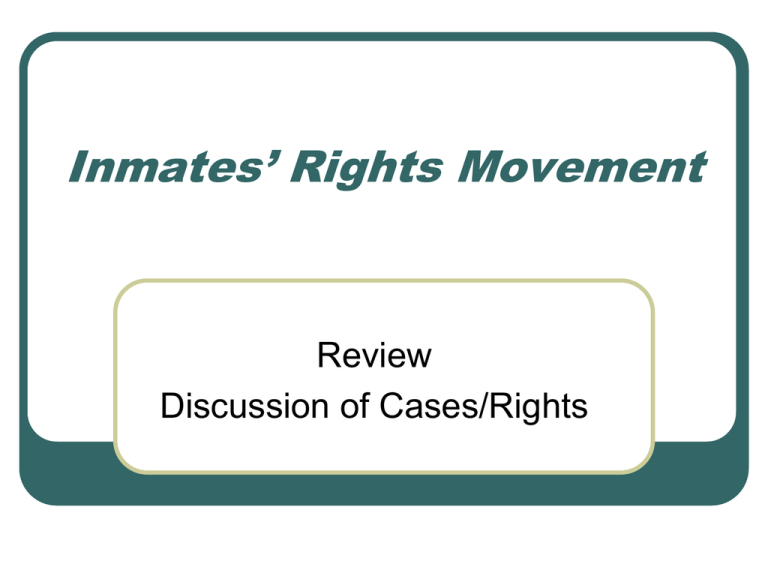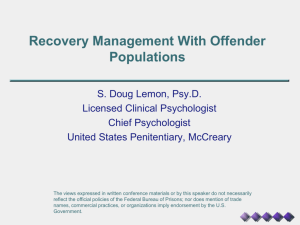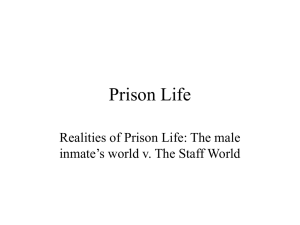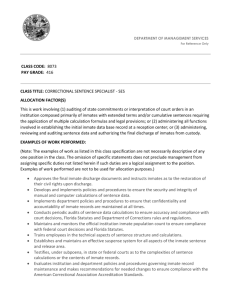Inmates' Rights Movement
advertisement

Inmates’ Rights Movement Review Discussion of Cases/Rights The “Hands Off” Doctrine Prior to 1964 • Prisoner as “Slave of State” and “civilly dead” • Even if they may have some limited rights… • Judges reluctant to interfere with executive branch • Federal judges versus state prisoners (states rights) • Judges not penologists (safety of prisons) • Fear flood of frivolous inmate law suits Inmate Rights Period (1964-1978) Why during this time? • Inmates, like others, become more • • • • militant/aggressive Public interest law (ACLU, NAACP) Judges more interested in “politically disadvantaged groups” Interpretation of the Civil Rights Statute allows inmates to file Section 1983 suits Horrible conditions of confinement in cases • Incarceration rates soar without new prisons Two type of suits Habeas Corpus • Long history, challenge legality of confinement Section 1983 • Allege violation of constitutional rights by person “under color of state law” • Sue for damages ($) or remedial relief (change in policy/conditions) By late 1980s, inmates are filing twice as many Section 1983 suits as Habeas suits Major Areas of Section 1983 Litigation Access to Courts Individual Rights • Medical treatment, freedom of religion, mail (get/receive)… Due Process Cruel and Unusual Punishment • Revocation of good time, prison transfers… • Individual guard-inmate interactions, “totality of conditions” cases Access to Courts Cooper v. Pate (1964) • Inmates may bring suit via Section 1983 to challenge state actions Johnson v. Avery (1969) • Prison officials cannot bar “jailhouse lawyers” unless they provide a reasonable alternative Nutshell = provide adequate law library & assistance from other inmates • Or access to lawyers Individual Rights General: • Turner v. Safely (1986) • Prison regulations that impinge upon inmates’ constitutional rights are valid if they are related to a reasonable penological interest • Prisons may ban inmate to inmate correspondence • Prison officials may not regulate inmate marriage • No Reasonable expectation of privacy in cells • Body cavity search after contact visit is OK • No right to observe “shakedown” of cell In a nutshell The nod goes to prisons Individual Rights II Medical Growing area of concern (AIDS, elderly inmates) • Current Standard from Estelle v. Gamble (1977): • “Deliberate Indifference to serious medical needs” • Estelle: Inmate with back injury from work. Failure to take X-rays not malpractice (inmate seen 17 times by Rx) • Examples of DI: • • • Doctor chooses easier but less effective treatment (throw away ear and stitch stump) Injection of penicillin with knowledge that prisoner was allergic and refusal to treat reaction Prison doctor refuses to administer prescribed painkiller for surgery 8th Amendment When do prison conditions rise to the level of “cruel and unusual” punishment? • Correctional Officer Use of Force • Must prove that officials acted maliciously and sadistically with intent to cause harm • BUT, harm does not have to be permanent (Hudson v. McMillian, 1992). • Other Conditions of Confinement • Food, cell size, double bunking, crowding, noise, second hand smoke… 8th Amendment Cont. Landmark Conditions of Confinement Case = Ruiz v. Estelle (1980) • Judge (federal district) William Wayne Justice • Confinement in Texas prisons constituted cruel and • unusual punishment (brutality by guards, overcrowding, understaffing, use of building tenders, poor medical care, and uncontrolled physical abuse among inmates) Consent Decree, Special Masters By 1995 • Almost a third of all correctional institutions across the nation were under state or federal court orders to limit prison populations or improve the conditions of confinement 8th Amendment cont. In 1980s, 1990s • “Totality of Conditions” not enough must show that prison officials acted with deliberate indifference to some basic need of the inmates • Cannot use “totality of conditions” • Not enough to show the conditions persisted over a long period of time (deliberate indifference) Due Process Wolff v. McDonnell (1974) • Inmates are entitled do due process in prison • • disciplinary proceedings that can result in loss of good time or in punitive segregation Advanced written notice, written statement of wrongdoing and action taken, can call witnesses and present evidence… • NO: cross examine (inmate confront CO), legal counsel Due process also for transfer to mental hospital but NOT for: • Transfer to different prison, removal to solitary confinement, denial of visitor… Prison Litigation Reform Act (PLRA) of 1997 • • • • • • Limits remedies available to federal courts (only what is justified by constitutional violation) Inmates must pay partial installments filing fees out of their inmate accounts (based on % of money in account) 3 strikes ban on “frequent fliers” If a prisoner receives $, must first pay any outstanding restitution orders/fines/fees (other limits) Must exhaust both prison grievance system and state court system Courts may not enter into consent degrees with prisons (no special masters) Backtracking PLRA + Supreme Court Decisions • Inmate Section 1983 suits have declined, • • even as prison populations have increased 1990 = 40,000 claims 2000 = 24,000 claims • Habeas corpus has climbed back ahead of Section 1983 suits now about same prevalence • 2002: 24,0000 Habeas to only 23,000 1983 Suits What has been the outcome of the Inmates’ Rights movement? Practical Legal Rights/Better Conditions? • Few cases (less than 2% succeed) and the legal “victories” are fairly basic • Improvements in living space, medical care, working conditions, procedural protections, better inmate grievance systems…. Larger context? • Fear of lawsuits Greater bureaucratization • But, breakdown of stability/order? SEE TEXAS • Inmate expectations/CO morale? The Stanford Prison Experiment Basic Experimental Design Findings? • Participants? • Methods? • “Guards” • “Prisoners” • Implications for Prisons A Critique of the Stanford Experiment Did the participants really undergo a “transformation?” • • Really think they were “prisoners” or “guards?” • Nyon cap instead of shaved head, Zimbardo as superintendent Really think they had been “arrested?” Alternative explanation • • • Acting on cultural stereotypes--esp. for guards Effect of “living up to agreement” of scientific study • Milgram experiment • Otherscan’t design an experiment where people would quit Know research hypothesis a priori? Abu Ghraib Explanations similar to that for correctional officer brutality 1. Bad COs (Rural Virginia “hillbillies”) 2. Prisons as bad institutions (Stanford Experiment) 3. Poor Organization/Governance





